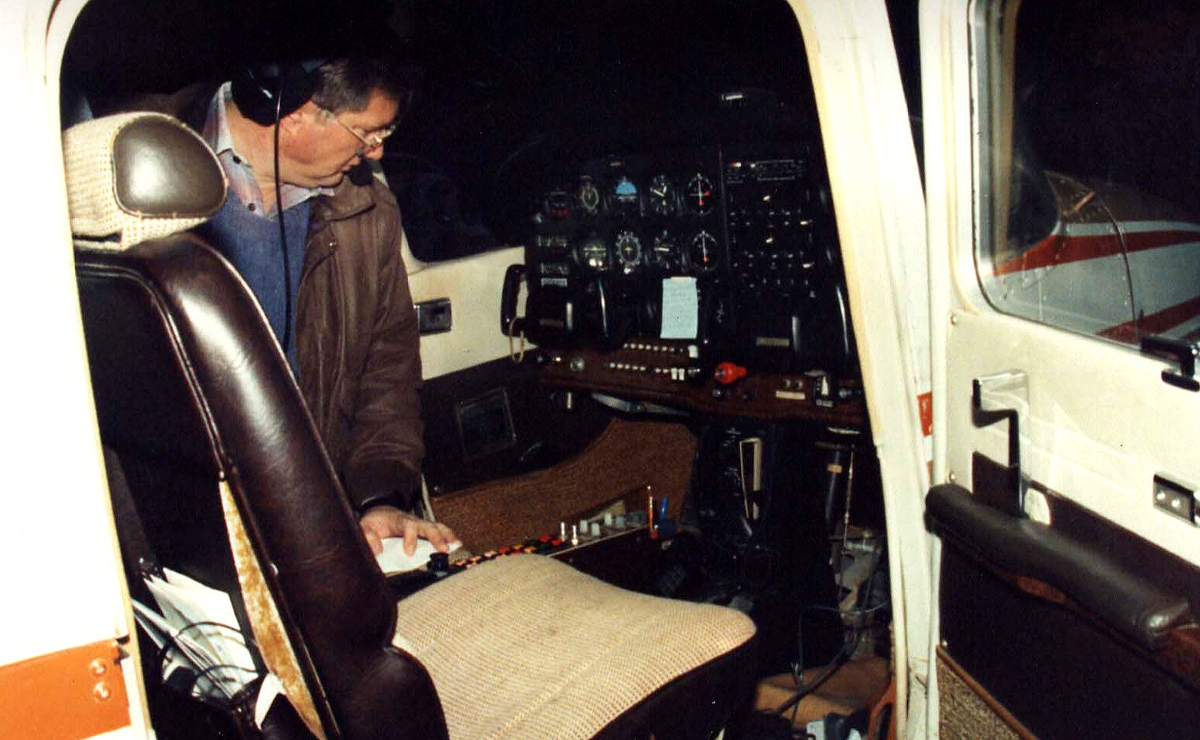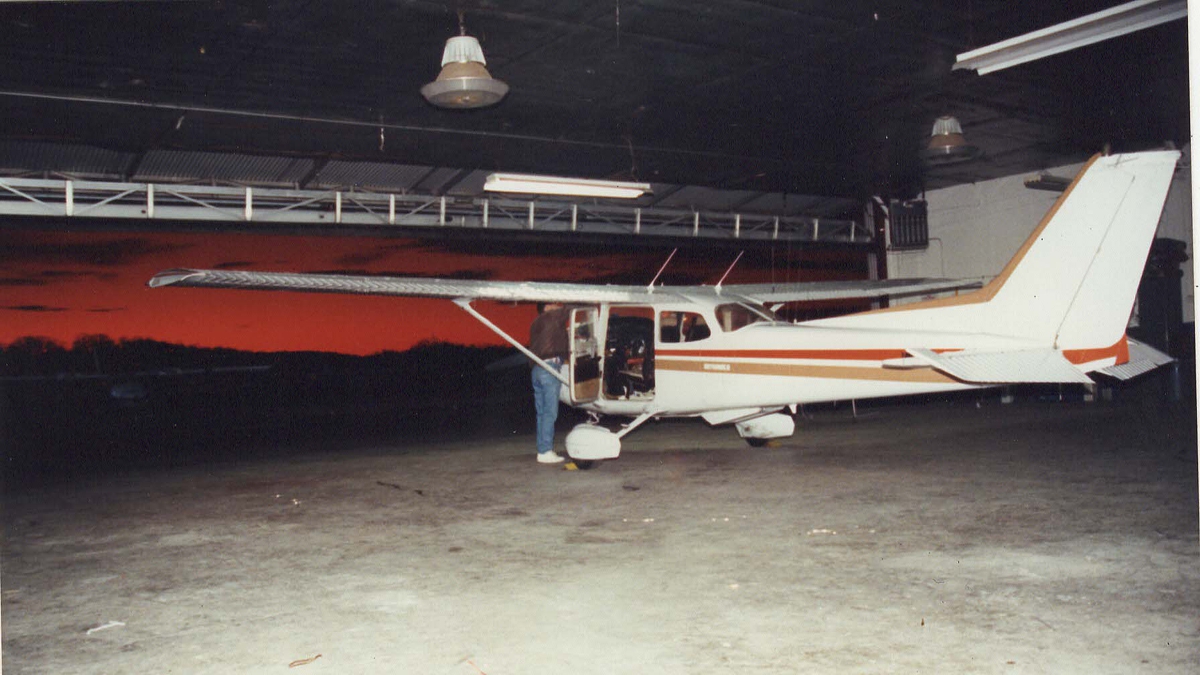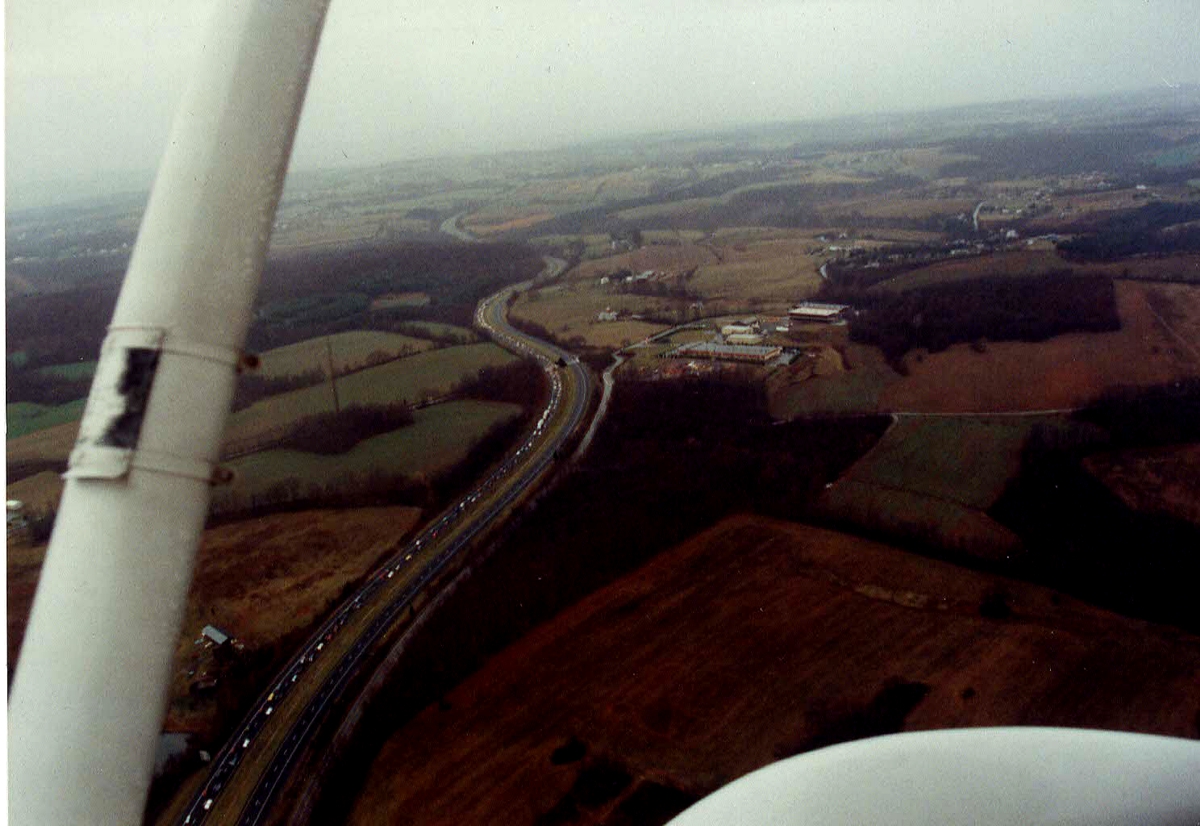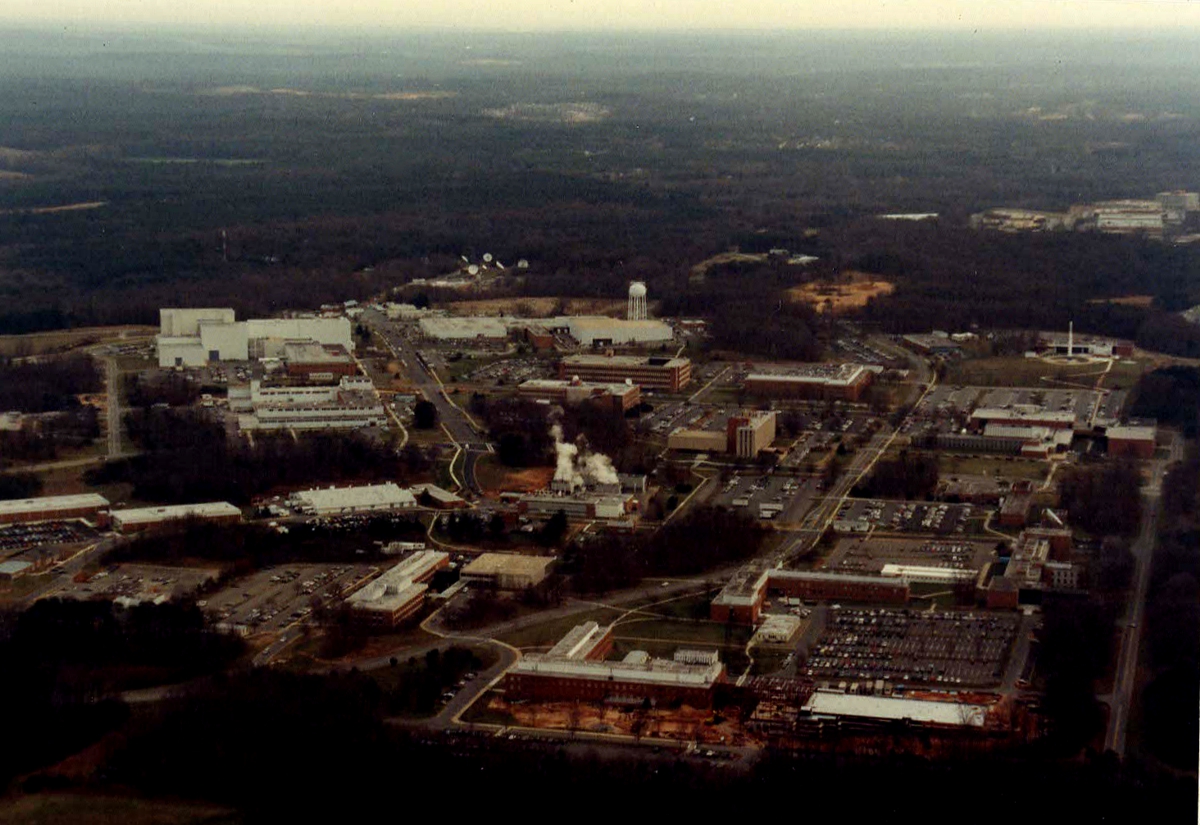December 23, 1991
Yesterday, the Sun shown at its zenith on the Tropic of Capricorn, 23.5 degrees south of the Equator. The plane of the Earth's orbit would allow the angle to increase no further. Winter had begun and tomorrow is Christmas Eve. It is dark as Walt Starling pushes N52870 out of the hanger at College Park airport, but the Eastern sky is red with purple clouds as the sun rises imperceptibly sooner instead of imperceptibly later as it had been each day since September 23.

Walt is dressed as most of us would like to when going to work - jeans, sneakers, and flannel shirt. The lights of the communications console in the Cessna 172 provide a sense of warmth in the cold morning; LTT, VHF, NAV - red, white, and yellow indicators located on the floor between the seats, The first two indicators represent Walt's link with WLTT, W-Light radio, 94.7. He's about to take to the air and help the Washington, D.C. area cope with the rush hour traffic.
 Starling had already preflighted the Skyhawk and made his first broadcast at 0650 while still in the hanger. The quality sound emanating from the comfortable Marti headset is clear even during the runup. Runup complete and flight controls free, Wait announces possession of runway 31 and the Cessna is rolling.
Starling had already preflighted the Skyhawk and made his first broadcast at 0650 while still in the hanger. The quality sound emanating from the comfortable Marti headset is clear even during the runup. Runup complete and flight controls free, Wait announces possession of runway 31 and the Cessna is rolling.
A few minutes later the lights of Langley, then Wheaton Plaza, its parking lot empty except for some early arriving employees, passes below. Car lights are moving well- spaced on the Beltway and other arteries. It looks like a Sunday morning. Crossing the Potomac, the Sun is high enough for Starling to engage the autopilot and scan the headlines; from the look of them, cartography will be one field of endeavor free from the fear of layoffs, as the rearrangement of the once Evil Empire continues.
Starling's counterpart with WMAL, Ed Parks, keeps him updated about a fire near the intersection of the John Hanson Highway and 495 which is causing a minor slow down. The third member of the three aerial traffic reporters who fly their own aircraft in the Washington area, from WTOP, is absent. Lost his contract, it is said. Maybe the recession is affecting this branch of endeavor too. $150,000 annually is invested in research to discover what listeners want, to learn what boosts ratings. Apparently the ratings have been favorable for Walt - he's been flying traffic in the area for 18 years.
 |
Past Dulles it's getting rural and nothing doing. Starling heads south and east and passes on the latest developments on the J.H. fire and a warning to slow down when approaching emergency equipment. Over Fairfax he greets his listeners with an "It's sunrise, Washington - turn off your headlights!" He's in a good mood. Yesterday he was able to give his wife Sharon, a major surprise birthday party. Their children, Brent, 14, and Joanne, 10, both love flying and plan on earning their own tickets someday.
The next broadcast is friendly banter and "nuthin', nuthin', nuthin'" happening. Traffic is widely spread and moving smoothly. The cool dense air is smooth too, and the city lights sparkle below while the red sunrise shifts to gold above. Walt gets paid to do this. Every day.
Heading northwest toward Sugarloaf mountain, the traffic reporters and Metro police who are in the air also are treated to the sight of a double rainbow, arching from somewhere near Frederick in the West to somewhere near Baltimore toward the northeast. Above the center of the arch, a waning gibbous moon occupies a remaining patch of blue sky lightened from the sunrise, while all below is shadowed and gray with approaching rain. The flyers share their versions of the mariner's rhyme about the colors of sunrises, meanings of rainbows in the morning, and other weather folklore, All agree that it is going to rain.
sight of a double rainbow, arching from somewhere near Frederick in the West to somewhere near Baltimore toward the northeast. Above the center of the arch, a waning gibbous moon occupies a remaining patch of blue sky lightened from the sunrise, while all below is shadowed and gray with approaching rain. The flyers share their versions of the mariner's rhyme about the colors of sunrises, meanings of rainbows in the morning, and other weather folklore, All agree that it is going to rain.
Turning southwest again, more of the same on the ground. It looks like it is going to be a quiet watch. Or that's what Walt and everyone else expect, The first report of trouble comes a few minutes later - 0745- multi-car pileup on 270 at route 109, near Hyattstown. On top of it another on Rockville Pike, route 355. "...sheet of ice...", "...skating rink..." - the metaphors issue forth as the rain advancing from the north and west touches the cold road surfaces and solidifies.
Over National Airport, East over John Hanson highway, past Freeway airport, all is calm. The mood is lightened a bit as a discussion ensues on the whereabouts of the pot of gold; the rainbow
 |
 |
is fading, but still visible. One suggests it's in the hanger at College Park, a reference to Flying Machine, Inc., the aircraft repair and restoration business which occupies Walt's life when he's not in the air or with his family. Walt explains that the rainbow's end moves with the relative positions of the observer, the sun, and the rain. Someone else adds that the relative positions of the valve stems on your tires is also a factor. Starling replies "I thought you knew that".
Eight AM, heading northwest, Starling receives word that a traffic advisory has been issued, and relays the message to his audience. While Walt is checking Georgia Avenue, over Liesure World, Dave Adler on the ground asks Walt if he knows the make of car involved in the I- 270 accident; a listener fears her husband might be involved. Starling doesn't know, but passes on the assurance that their are no injuries involved on this one. He’s using the UHF transmitter for this, as well as receiving his cues. "...30 seconds, Walt, for Ritz Camera..."
Passing Montgomery airpark, temperature at 1300 feet is 45 degrees. Sugarloaf looms in the grayness, the rainbow, its warning given, is no longer visible. Walt explains to listeners how it can be 45 in the air and freezing on the ground. Those signs that say “bridge freezes before highway" mean it. Parts of I-270 are closed. Starling tells everyone to go have a cup of coffee until the roads have warmed up,
At 8:15 the rain climbs the windshield as Starling approaches the mess near the Montgomery-Frederick County border. Visibility is miles and miles at 1500 feet in spite of the rain and the Skyhawk’s thermometer indicates 48 degrees outside, but the line of lights and emergency flashers below tell a different story. The cloud line advances toward the rising sun. Jim Russ from WMZQ is in the air looking over the situation too, call sign 80 Hotel. Walt turns south behind him. Call sign Quebec Sierra is Tom Fanning of WPGC. Russ and Fanning are being flown by pilots unknown. Montgomery County has a traffic engineer in the air too, Accidents on Clopper Road, Shady Grove road; they’re proliferating too fast to track.
At 815 Starling broadcasts Frederick, Prince William, Montgomery counties all reporting freezing rain. "...get chat cup of coffee...stay put...you’re not going anywhere...", he warns again. Keeping Dave aware of his position, he reports over Germantown headed for Cabin John. Nothing is stirring below at Burning Tree and the houses of wealth in Potomac. Great Falls is peaceful in the shadows below; looking southeast the sunrise is paling to yellow as it fights a losing battle against the advancing front. There is no trace of turbulence. Sanding crews are reported out at 8:30; Walt reports over Wolf Trap headed toward Dulles again. 355 is reported open, at least in one direction.
 |
Walt’s 8:45 update announces accidents in Prince William, Loudouin, and Fairfax counties, He takes a close look at a backup on route 28 in Mannassas park while describing developments throughout the area; Interstate 270 - route 121 - 111 - 124 - 29 - 234. Route numbers and call signs blend while an airliner passes well above and a helicopter well below. Starling’s casual performance gives new meaning to the term “situational awareness".
A few minutes later things are quiet enough for Starling to consult an ADC street map while passing over Fairfax. He keeps a stack of them behind the seat. There’s a bit of cab driver knowledge of the area needed in this business too, only the area covered is considerably greater. WLTT’s 50,000 watt broadcast range is better than 50 miles, but Walt’s 15 Watt transmitter can cover most of it with altitude. He has on occasion gone to 5,000 feet to cover an unusual distant event, but generally remains within the area of most interest to D.C. drivers - the Beltway west as far as Dulles, Northern Virginia, and I-270 in order to cover the Frederick and Hagerstown commuters. The flying reporters stay out of each other’s way and share information readily; pooling resources allows for wide and timely coverage.
A 737 makes its roll on National runway 18 below. The sun is still bright toward the Wilson Bridge; to the north, gray and foreboding. Starling’s frequent transits of the TCA are hardly noticeable. The traffic reporters have permanently assigned squawk codes and there is little fuss in their comings and goings. At 9:02, Starling announces D.C. and Prince Georges Counties are having no problems, but many Christmases are being ruined in the other counties.
There is discussion of fuel status in the air; some are contemplating returning to refuel or call it a day, but Walt’s fuel gauges are still showing nearly full. He bought this 172 specifically for traffic reporting - it carries a 50 gallon tank and burns about 8 an hour, 9 with the air conditioning running. Walt describes the latter as the most important piece of equipment on the aircraft.
Passing Goddard Space Flight Center in Greenbelt - at 9:08 Dave Adler tells Walt he’s starting a play-4 session. Some might call W-lite’s repertoire "heavy elevator music." Four in a row; Who will it be? America? Simon and Garfunkel? Christopher Cross? Don’t laugh - it’s popular, it’s pleasant, it works, Like a padded refuge after a long session with WHFS or MTV.
|
|
We're still in the air at 9:14, flying back into the rain over White Oak. On overtime, if there was such a thing in Walt’s contract. There isn’t. Walt gets paid whether he flies or not. In this year’s drought, he was in the air almost every working day rush hour - the station got its money’s worth,
The rain has reached College Park as Starling brings the 172 into the downwind for runway 15. It’s 9:21, He touches down on tje numbers; the runway is wet but he makes the first turnoff with no problem. Let’s see...2 landings per day 5 days per week, never mind vacations and holidays, that’s 520 per year x 18 years...the man should be proficient. It seems he likes to fly - caught the fever from his dad, who got his ticket in 1947. Walt holds commercial, instrument, multi-engine and sail plane ratings and an accumulation of 17,000 hours.
In 1974 his professor at the University of Maryland thought his paper on traffic reporting so silly he refused to grade it, so Walt quit school and converted the paper into a proposal for a contract, which he was awarded with WAVA. He went back and earned his degree after the professor was gone, but never stopped traffic reporting. Doesn’t want to either. If he needs variety, there’s always Flying Machine’s big black and white Stearman.
Dave Adler asks if Walt is still with him. Walt does one more broadcast from the ground as he taxis up to the fuel pumps and kills the mixture. He summarizes the eventful morning, sympathizing with the unfortunate victims. The ice is gone now, but he cautions drivers to use care - the roads are still wet and slick.
Tuesday morning, Walt is back in the air, on the air, discussing yesterday’s calamity with Dave on the ground. Today, Christmas Eve, there is no traffic. He is taking the next week off. He’ll be back after the New Year. Today, the traffic report is ",..nuthin’, nuthin’, nuthin’ ."
Today, so it stays.
Epilogue:
Walt Starling succumbed to cancer in 2005. He was only 52.

